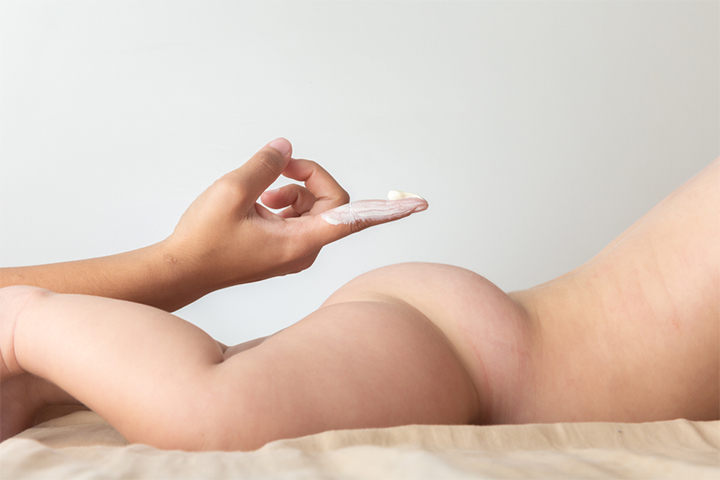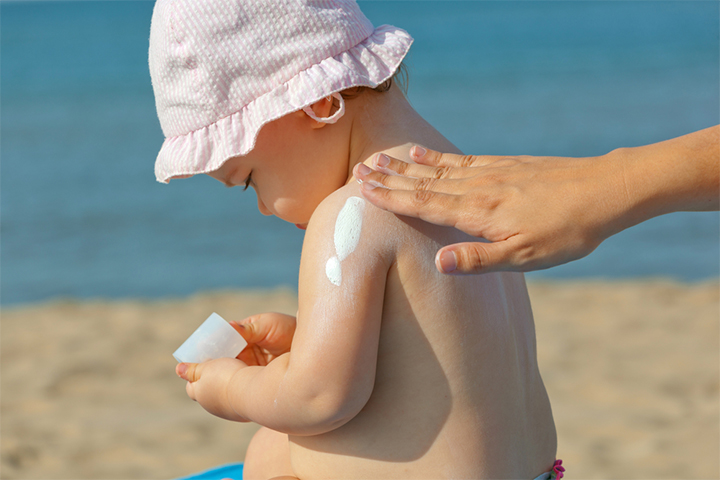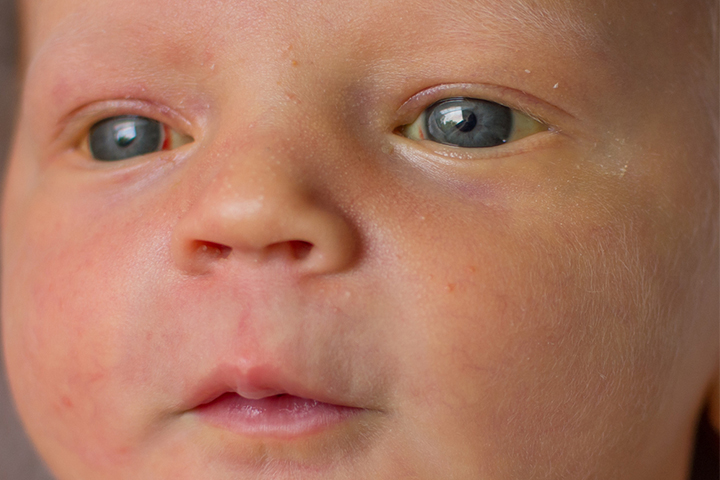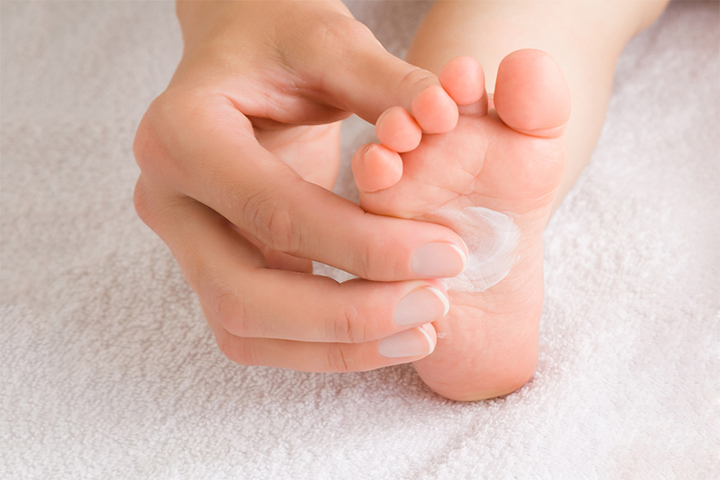Due to its skin-protective properties, using zinc oxide for babies is mostly considered safe. As a result, it is often an active component in sunscreens, baby powders, baby lotions, and other skincare products. For example, calamine lotion, a topical treatment for skin irritation, is one of the most popular zinc oxide-containing skincare products for babies.
Since zinc oxide is widely used, you’re likely to encounter it in at least one babycare product. Therefore, knowing whether this compound is truly safe can help you make the best skincare choices for your baby.
This post discusses the safety, side effects, potential advantages, and precautions to consider when using products containing zinc oxide for babies.
Is Zinc Oxide Safe For Babies?
The topical application of zinc oxide is considered safe for babies’ skin (1). Research indicates that the compound’s nanoparticlesiXParticles less than 100 nanometers in size widely used in medicine (drug delivery) and healthcare applications linger in the skin’s epidermis and do not penetrate the deeper dermis layer. There is also no cellular toxicity noted due to repeated topical use of zinc oxide.
The compound is approved for use in skincare products by the U.S. Food and Drug Administration (FDA). The concentration of zinc oxide is limited to 25%, which is the safe limit (2). Considering the extensive research and FDA approval, zinc oxide can be noted as safe for babies when used topically.
Uses Of Zinc Oxide For Babies
Zinc oxide is found in several baby skincare products. The compound could be used in the treatment or management of the following conditions in babies.
- Diaper rash: According to the Lincoln Medical Center, diaper rash is prevalent among 50% of infants. Diaper rash can be uncomfortable for babies. Lindsay Boever, a mother, shares the symptoms that she observed in her little one. She says, “Poor Baby! She constantly has a diaper rash. She has the kind right now that I have to change her diaper every 20 minutes. It is crazy red and burns her so badly. I have tried Aquafor, Desitin, Coconut Oil, Lotrimin, and Corn Starch. I don’t use wipes. I give her a bath, wash her bottom every time with anti-bacterial soap then let her air dry for as long as I am able. But, nothing is helping and I want to cry every time I change her because she sucks her stomach in, sucks in air, and cries so hard (i).” Zinc oxide-based ointments and lotions, such as calamine lotions, are often used as a safe home remedy for a baby’s diaper rash (3). Zinc oxide is an antipruritic agent, meaning it provides relief from itching. It can be safely used even for babies younger than six months.
- Dermatitis: Dermatitis or eczema is an autoimmune conditioniXA group of medical conditions where the body’s immune system erroneously attacks healthy cells causing excessive skin inflammation, redness, and irritation. Zinc oxide-rich lotions, such as calamine lotions, can help relieve itching and irritation due to the compound’s anti-inflammatory properties (4). It could be a safe alternative to corticosteroidsiXSteroid hormones produced in the adrenal cortex that help alleviate inflammation and the immune system activity, which require a doctor’s prescription for administration.
- Skin irritation: Zinc oxide-based ointments could be used as a home remedy to relieve skin irritation due to insect bites, contact with irritant plants, and friction.
- Sunburn: Experts recommend checking for the presence of zinc oxide while selecting a baby sunscreen lotion since the compound protects the skin from sunburns (5). The compound may provide broad-spectrum protection against UVA and UVB rays depending on the overall formulation of the sunscreen lotion.
- Certain skin conditions: Zinc oxide-based medicated ointments may be prescribed to treat certain skin conditions. A few examples are warts, skin ulcers, and some types of skin wounds. The likely reason could be the antibacterial and antioxidantiXSubstances that may prevent or slow down cell damage caused by harmful molecules called free radicals properties of the compound (6).
Besides these uses, zinc oxide may also be found in regular baby soaps, skin moisturizers, and talcum powders. It may also be found in certain types of suppositories and may be used locally in treatment of hemorrhoidsiXA condition in which the rectal and anal region veins get swollen (7).
Side Effects Of Zinc Oxide In Babies
An allergic reaction to topical zinc oxide is extremely rare, considering it has anti-inflammatory properties useful for relieving allergy-related skin conditions, such as eczema (8). Most side effects of zinc oxide arise due to accidental ingestion or inhalation of its fumes (9). Inhalation of zinc oxide fumes usually occurs in an industrial setting, and it is highly unlikely that an infant will be exposed to it. Therefore, the only potential risk for the baby is accidental ingestion of zinc oxide-based lotion or ointment.
The ingestion of zinc oxide is a case of accidental poisoning and could lead to the following side effects (10) (11).
- Chills and fever
- Diarrhea
- Vomiting
- Stomach cramps
- Cough
- Mouth and throat irritation
- Yellow skin and eyes
Take your baby to the emergency room immediately if you notice any of the symptoms. Remember to carry the bottle or container of the zinc oxide product so that the healthcare provider can provide a relevant antidote based on the product’s formulation.
Precautions While Using Zinc Oxide
The following precautions could help in the safe use of zinc oxide for babies.
- Although zinc oxide is safe, the product may have other compounds that could be potential allergens, particularly for those with sensitive skin. Remember to check all the ingredients. Do a patch test on a small part of the skin, such as on the baby’s feet, to check suitability. Consider selecting fragrance-free and hypoallergenic options to minimize the risk of adverse reactions.
- Apply a thin layer on the affected area and repeat after a few hours instead of applying a thick layer for better results.
- If you are using a zinc-oxide-containing diaper rash cream, change the diaper often since it may absorb some of the cream.
- Keep zinc oxide-containing products away from the baby’s reach to prevent accidental ingestion.
- Avoid products containing zinc oxide if your child is allergic to zinc, lanoliniXA waxy, oily material derived from sheep’s wool often used as a skin moisturizer, cod-liver oiliXA nutrient-rich oil obtained from fish, known to be a good source of vitamins and omega-3 fatty acids, petroleum jelly or mineral oils.
Zinc oxide for babies is considered safe for topical application. Hence, it is found in many baby skin care products. Products containing zinc oxide are effective in soothing nappy rash, dermatitis, sunburn, and several other conditions. However, keep the container away from the baby’s reach to avoid accidental inhalation or ingestion. Accidental exposure may cause diarrhea, vomiting, and yellowing of skin and eyes. Further, it is best to perform an allergy test before using zinc-oxide products in combination with other ingredients.
Key Pointers
- Topical application of zinc oxide is safe for babies and can be found in many baby skincare products.
- The compound has antibacterial and antioxidant properties and can treat conditions such as eczema, rashes, and other skin-related discomforts in babies.
- Certain side effects such as vomiting or fever may arise if the baby accidentally inhales the product.
- Be careful not to overapply and consult your child’s doctor before using it on your baby to avoid any adverse reactions.















